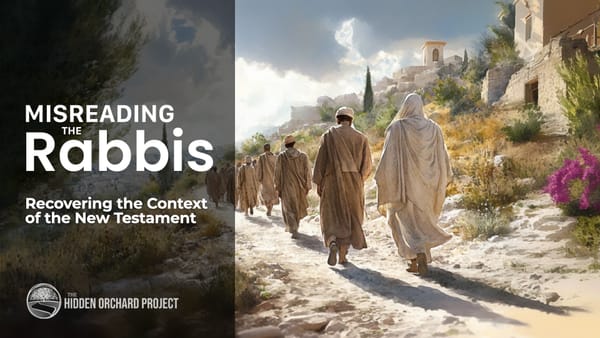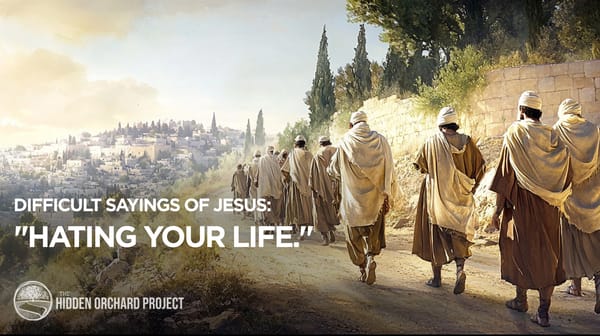Angels Ascending and Descending on the Ladder
Jesus quotes a very deep midrash in the Gospel of John. Many readers miss this reference, but his audience did not. Journey with us as we unpack these metaphors and seek understanding.

Skipping the infancy narratives and genealogies, John's Gospel opens with deep kabbalistic imagery, describing the origin and manifestation of the Soul of Messiah, also known as Adam Kadmon¹.
These opening lines require some familiarity with the super-structure of Jewish cosmology², otherwise, a reader may be off to a confusing start.
Nevertheless, much of the first chapter highlights various testimonies and recognitions that this ancient Soul has manifested within a particular Galilean Jew, Jesus.
After Jesus's immersion (mikveh) in the Jordan River, he is approached by a few Galileans who are discussing the tradition of Messiah. We read;
“Philip found Nathanael and said to him, “We have found him of whom Moses in the Law and also the prophets wrote, Jesus of Nazareth, (ben Yosef) the son of Joseph .”
In this passage, the author references that Jesus is the "son of Joseph," most likely an allusion to the Rabbinic tradition of the Josephic Messiah³.
Nathanael said to him, “Can anything good come out of Nazareth?” Philip said to him, “Come and see.” Jesus saw Nathanael coming toward him and said of him, “Behold, an Israelite indeed, in whom there is no deceit!” Nathanael said to him, “How do you know me?” Jesus answered him, “Before Philip called you, when you were under the fig tree, I saw you.” ... Nathanael answered him, “Rabbi, you are the Son of G_D! You are the King of Israel!” Jesus answered him, “Because I said to you, ‘I saw you under the fig tree, you believe? You will see greater things than these.”
This section is packed with many hints, and the tradition behind 'Nazareth' will be a future article of its own. The fig tree⁴ carries significance in Rabbinic thought but also connects us with the creation narrative and Adam, which will make sense shortly.
For now, it is the following passage we will focus on:
And he said to him, “Truly, truly, I say to you, you will see heaven opened, and the angels of G_d ascending and descending on the Son of Man.”
- John 1:45-51
Adam's Design
Before Adam's error in the Garden, he was created unique in the universe. The Talmud tells us:
The height of Adam the first man reached from the ground to the skies, as it is stated: “Since the day that G_d created man upon the earth, and from one end of the heavens” - Chagigah 12a
In one Midrash⁵, we read that "[Adam] filled the world from East to West." Another says, early on, the angels nearly mistook Adam for Divine!
When the Holy One Blessed be He created Adam, the first man, the ministering angels erred with regard to Adam and sought to declare before him, Holy.
- Genesis Rabbah 8:10
What do we make of these? In summary, these can be understood as a euphemism for Adam's expansive spiritual capacity. Adam was created with a certain quality that fused within him both Heaven and Earth. That is, he spanned both the upper and lower worlds, connecting the above and below.
On a global scale, his obedience, or disobedience, could influence the flow of Chesed (blessing) and Gevurah (judgment) into the world. This is true of all of us but to a lesser degree.
The Ladder
Metaphorically, Adam was like a "ladder."
“(Adam) Man is a ladder planted on earth whose head reaches heaven and the angels of G_D ascend and descend it.” - Toldot Ya’akov Yosef 50
After his error in the Garden, Adam fell from this position. No longer a ladder to the upper worlds, he brought a collapse to creation, impairing our connection to the Creator. To restore this, humanity will need a new ladder.
This begins to draw us closer to the words captured in John.

Jacob's Ladder
In Genesis 28, we read about Jacob's vision of a ladder, Sulam (סֻלָּם)⁶. When Jacob had his vision, he realized that the ladder itself represented something much deeper. One commentary, states:
This [ladder] is the gateway from which the angels ascend to heaven or descend to earth. When G_D appeared to be standing on top of the ladder, Jacob realized that the site he was lying on was the gateway to heaven, and that it was an appropriate place for prayer. The Holy Temple is the House of G_D. Yaakov realized that the Holy Temple was of crucial importance in channeling communication from man to G_D and vice versa. - Rabbeinu Bachya on Genesis 28:12
As we learned above, the ladder can be understood as a multi-faceted metaphor for our connection to the Creator. Rabbinic tradition also connects the rungs of a ladder to the layers of the human soul⁷.
Recapping what we've learned so far, the ladder can represent:




